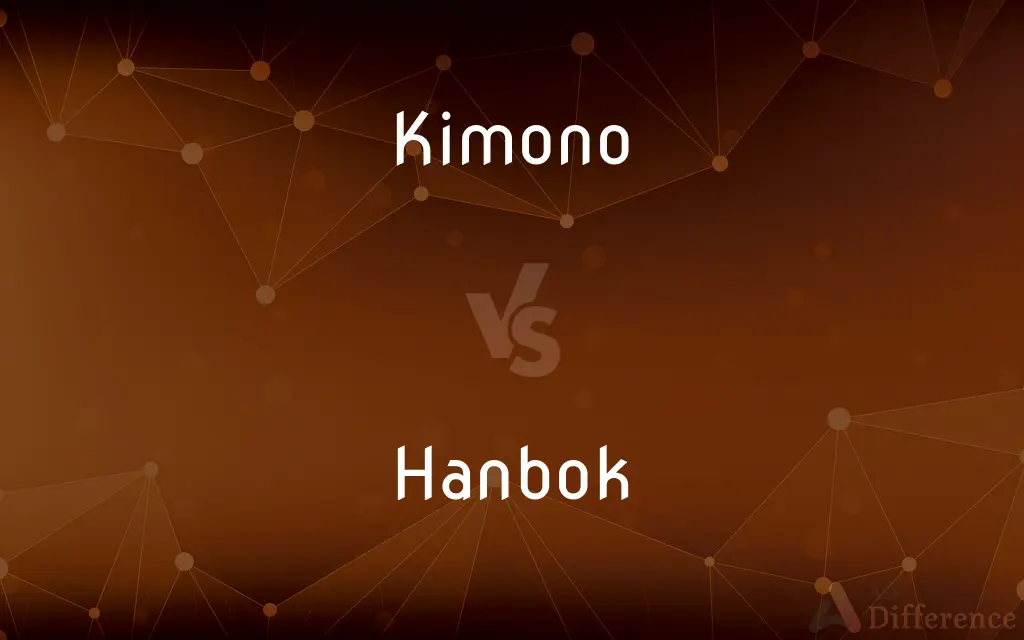Kimono vs. Hanbok — What's the Difference?
By Fiza Rafique & Urooj Arif — Updated on April 24, 2024
Kimono, a traditional Japanese garment with T-shaped, straight-lined robes, contrasts with the Hanbok from Korea, noted for its vibrant colors and simple lines.

Difference Between Kimono and Hanbok
Table of Contents
ADVERTISEMENT
Key Differences
Kimono traditionally symbolizes Japanese cultural aesthetics, emphasizing formality and intricate patterns, while the Hanbok reflects Korean heritage with its emphasis on comfort and ease of movement. Both are deeply ingrained in their respective cultural ceremonies.
The Kimono often features luxurious fabrics like silk and complex designs, including layered colors and symbolic decorations, whereas Hanbok is celebrated for its unique structure, comprising a jeogori (blouse) and a chima (skirt) that allow more freedom.
Kimono is usually worn during formal events and significant occasions such as tea ceremonies and weddings, on the other hand, Hanbok is worn in Korea for festivals and celebrations, but also casually in modern adaptations.
The wearing technique of a Kimono involves numerous steps and accessories, including the obi (belt), which is a skill in itself, while the Hanbok is relatively simpler to put on, focusing on the artful tie of the otgoreum (a ribbon).
Maintenance of a Kimono can be quite elaborate, requiring specialized care and storage methods to preserve the garment's condition and aesthetic value, whereas Hanbok, with its lighter materials and fewer layers, tends to be easier to handle and store.
ADVERTISEMENT
Comparison Chart
Origin
Japan
Korea
Typical Fabric
Silk, sometimes with gold or silver
Silk, hemp, or cotton
Components
T-shaped robe, obi (belt)
Jeogori (blouse), chima (skirt)
Occasion for Wearing
Formal events, tea ceremonies
Festivals, celebrations, daily wear
Ease of Wearing
Complex, multiple accessories needed
Relatively simple, fewer layers
Compare with Definitions
Kimono
Used in various formal occasions and cultural practices in Japan.
During the festival, participants dressed in colorful kimonos.
Hanbok
A traditional Korean dress characterized by vibrant colors and simple lines.
For the celebration, she chose a bright red hanbok.
Kimono
A garment often made from silk and adorned with intricate patterns.
The museum displayed kimonos with historic embroidery.
Hanbok
Often worn during Korean traditional festivals and important family occasions.
They wore matching hanboks for the first birthday celebration.
Kimono
Typically worn with a wide belt called an obi, which is tied at the back.
He learned how to tie the obi for his kimono by watching tutorials.
Hanbok
Consists of a jeogori and a chima, which are easy to wear and comfortable.
The children wore hanboks made of lightweight cotton at the festival.
Kimono
Requires careful maintenance and storage to preserve its materials and designs.
Her grandmother passed down a kimono that required special care.
Hanbok
Generally easier to maintain compared to more elaborate traditional garments.
His hanbok was simple enough to wash at home.
Kimono
A traditional Japanese robe known for its long sleeves and wrap-around design.
She wore an elegant floral kimono to the tea ceremony.
Hanbok
Modern versions are adapted for casual wear in contemporary Korea.
She styled her hanbok with modern accessories for a unique look.
Kimono
The kimono (きもの/着物, lit., "thing to wear" – from the verb "to wear (on the shoulders)" (着, ki), and the noun "thing" (物, mono)) is a traditional Japanese garment and the national dress of Japan. The kimono is a T-shaped, wrapped-front garment with square sleeves and a rectangular body, and is worn left side wrapped over right, unless the wearer is deceased.
Hanbok
The hanbok (in South Korea) or Chosŏn-ot (in North Korea) is the traditional Korean clothes. The term "hanbok" literally means "Korean clothing".The hanbok can be traced back to the Three Kingdoms of Korea period (1st century BC–7th century AD), with roots in the peoples of what is now northern Korea and Manchuria.
Kimono
A long, wide-sleeved Japanese robe worn with an obi and often elaborately decorated.
Hanbok
The traditional Korean dress, often characterized by vibrant colours and simple lines without pockets.
Kimono
A loose, light robe worn chiefly by women.
Kimono
A traditional Japanese T-shaped, wrapped-front garment with square sleeves and a rectangular body, now generally worn only on formal occasions.
Kimono
(loosely) A yukata.
Kimono
A long robe-like garment in Western fashion, which may be open at the front, loosely inspired by the Japanese garment.
Kimono
(regional) A bathrobe or dressing gown.
Kimono
A kind of loose robe or gown tied with a sash, worn as a traditional outer garment by Japanese women and men. Women may wear it with a broad sash called an obi, having a large bow in the back. At present (1998), most Japanese wear it only at home or on ceremonial occasions, western-style clothing being more common in the workplace.
Kimono
A similar gown worn as a dressing gown by women of Western nations.
Kimono
A loose robe; imitated from robes originally worn by Japanese
Common Curiosities
Can hanbok be worn casually?
Yes, modern adaptations of hanbok are designed for casual wear, integrating traditional elements with contemporary fashion.
What is the significance of the kimono in Japanese culture?
The kimono is a symbol of traditional Japanese culture, representing grace, beauty, and social status.
How does the design of a hanbok enhance comfort?
The hanbok is designed with loose-fitting pieces that allow unrestricted movement, making it comfortable for wear.
What is the historical origin of the kimono?
The kimono evolved from traditional garments worn in Japan as far back as the Heian period (794-1185).
Are kimonos worn daily in Japan today?
No, kimonos are generally reserved for special occasions and cultural events rather than daily wear.
How is the hanbok significant in Korean culture?
Hanbok holds cultural significance in Korea, representing national identity and historical continuity.
What accessories are typically worn with a kimono?
Accessories such as the obi belt, zori sandals, and sometimes a handbag or fan complement a kimono.
Is there a particular season for wearing kimono?
Kimonos can be worn year-round, with fabrics and layers adjusted according to the season.
Do the colors of a hanbok have specific meanings?
Yes, the colors in hanbok often have symbolic meanings, with certain colors worn more during specific occasions or by specific people.
What materials are used in the making of hanbok?
Hanbok can be made from various materials including silk, cotton, and hemp.
What occasions are kimonos worn in Japan?
Kimonos are worn during tea ceremonies, weddings, and other formal or traditional events.
How are children introduced to wearing hanbok?
Korean children often wear hanbok during traditional celebrations and holidays from a young age.
How long does it take to put on a kimono?
Wearing a kimono properly can take considerable time, often requiring assistance due to its complexity.
Is hanbok evolving in modern fashion?
Yes, hanbok is evolving with modern trends, often seen in simplified forms that are easier to wear daily.
Are there different styles of kimonos for different genders?
Yes, there are distinct styles and patterns that typically distinguish men's kimonos from women's.
Share Your Discovery

Previous Comparison
Likeness vs. Similarity
Next Comparison
Axle vs. PivotAuthor Spotlight
Written by
Fiza RafiqueFiza Rafique is a skilled content writer at AskDifference.com, where she meticulously refines and enhances written pieces. Drawing from her vast editorial expertise, Fiza ensures clarity, accuracy, and precision in every article. Passionate about language, she continually seeks to elevate the quality of content for readers worldwide.
Co-written by
Urooj ArifUrooj is a skilled content writer at Ask Difference, known for her exceptional ability to simplify complex topics into engaging and informative content. With a passion for research and a flair for clear, concise writing, she consistently delivers articles that resonate with our diverse audience.














































